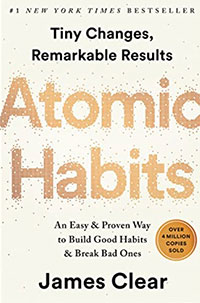
The point: Putting systems in place allows us to consistently implement small changes that lead to bigger changes over time.
Who is the book for: Anyone who inherently knows that their habits are tripping them up when trying to meet their goals or conversely the book could serve as a wake-up call for someone who is struggling to make lifestyle changes but is unsure why the process is dragging or is lacking momentum.
Key points:
- Changes that seem small at first will compound into awesome results if you consistently implement your system over time.
- Goals are about the results you want to achieve. Systems are about the processes that lead to results.
- You do not rise to the level of your goals, you fall the the level of your systems.
- Every action you take is a vote for the type of person you wish to become. The most practical way to change who you are is to change what you do.
Notes: The first step of behavior change is to make it obvious. The two most common cues are time and location. Making an implementation strategy around a time and place help make the habit automatic. It’s also possible to practice habit stacking to achieve this result (add the steps needed for the habit you want to improve upon with something you already do routinely).
Motivation is overrated and environment often matters more. It is easier to build new habits in a new environment because you are not fighting against old cues (anyone who is addicted to drugs or has a loved one who is take this to heart and advocate for a change in environment when looking to achieve long term success.) A reliable approach to change habits is to cut bad habits off at the source. Reduce exposure to the cue to the bad habit. For example, if you find yourself getting distracted by your phone all the time reduce your exposure to your phone by putting it out of reach or out of sight. To avoid unnecessary and detrimental cravings, we should highlight the benefits of avoiding a bad habit by making it seem unattractive. “Habits are unattractive when we associate them with negative feelings.”
“If you miss one day, try to get back into it as quickly as possible. The first mistake is never the one that ruins you. It is the spiral of repeated mistakes that follows. Missing once is an accident. Missing twice is the start of a new habit. This is a distinguishing feature between winners and losers. Anyone can have a bad performance, a bad workout, or a bad day at work. But when successful people fail, they rebound quickly.”
One downside of certain habits, James explains, is that we may stop paying attention to the smaller details and small errors. To counterbalance that we should review and reflect on the process over time to remain conscious of our own performance. Using a simple chart to convey his message, we learn that “the process of mastery requires that you progressively layer improvements on top of one another, each habit building upon the last until a new level of performance has been reached and a higher range of skills has been internalized.”
Overall, it’s the systems we put in place that allow us to change our habits and many small steps lead up to bigger changes.
Related Readings:
Habit Stacking: 127 Small Changes to Improve Your Health, Wealth, and Happiness by SJ Scott. Habit stacking works because you eliminate the stress of trying to change too many things at once. Your goal is to simply focus on a single routine that only takes about 15 to 30 minutes to complete. Within this routine is a series of actions (or small changes) that stack up over time to create larger changes.
Start Late, Finish Rich by David Bach. Although this book is focused on financial improvement, the related idea is to determine your values and then base your goals and actions on those values. The main question in the book can be asked in broader terms: In a perfect world if you and I were sitting together three years from today, what would have to happen for you to feel you have made not just good, but GREAT progress in your life? The process involves writing goals based on values. For example if one of my values (something I value) is security then I would write a goal and develop systems that would make me feel more secure in life. With security in mind, I could write a goal to save up a year’s worth of living expenses. The next step is to think about things that currently act as obstacles and develop strategies to overcome them. Here is on online version of his workshops: https://www.creativelive.com/class/start-late-finish-rich-david-bach
4 thoughts on “Atomic Habits by James Clear – Book Summary & Notes”